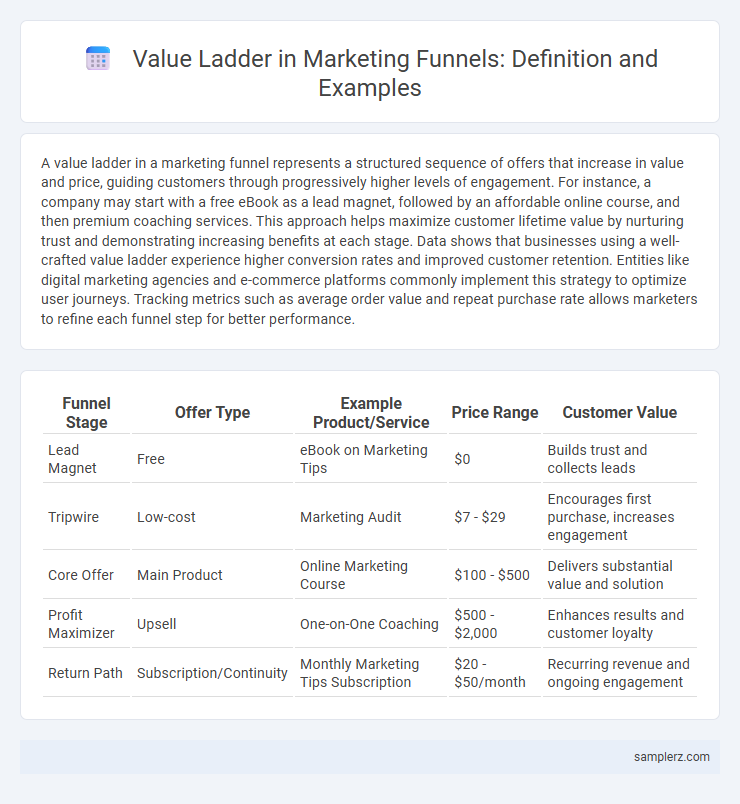A value ladder in a marketing funnel represents a structured sequence of offers that increase in value and price, guiding customers through progressively higher levels of engagement. For instance, a company may start with a free eBook as a lead magnet, followed by an affordable online course, and then premium coaching services. This approach helps maximize customer lifetime value by nurturing trust and demonstrating increasing benefits at each stage. Data shows that businesses using a well-crafted value ladder experience higher conversion rates and improved customer retention. Entities like digital marketing agencies and e-commerce platforms commonly implement this strategy to optimize user journeys. Tracking metrics such as average order value and repeat purchase rate allows marketers to refine each funnel step for better performance.
Table of Comparison
| Funnel Stage | Offer Type | Example Product/Service | Price Range | Customer Value |
|---|---|---|---|---|
| Lead Magnet | Free | eBook on Marketing Tips | $0 | Builds trust and collects leads |
| Tripwire | Low-cost | Marketing Audit | $7 - $29 | Encourages first purchase, increases engagement |
| Core Offer | Main Product | Online Marketing Course | $100 - $500 | Delivers substantial value and solution |
| Profit Maximizer | Upsell | One-on-One Coaching | $500 - $2,000 | Enhances results and customer loyalty |
| Return Path | Subscription/Continuity | Monthly Marketing Tips Subscription | $20 - $50/month | Recurring revenue and ongoing engagement |
Understanding the Value Ladder in Marketing Funnels
The value ladder in marketing funnels illustrates a strategic progression from low-cost, entry-level offers to high-value, premium products or services, enhancing customer lifetime value. By understanding the value ladder, marketers can design tailored touchpoints that nurture leads through targeted upsells, increasing conversions and revenue. This approach leverages customer psychology by delivering escalating benefits and trust at each stage, optimizing funnel performance and fostering long-term brand loyalty.
Why Value Ladders Matter for Funnel Success
Value ladders create a structured pathway that gradually increases customer commitment by offering progressively valuable products or services, enhancing conversion rates throughout the marketing funnel. By strategically aligning offers from low-cost entry points to premium solutions, businesses maximize customer lifetime value and foster trust. Optimizing value ladders in funnels ensures sustained engagement, higher average order values, and improved overall funnel performance.
Entry-Level Offers: The First Step in the Value Ladder
Entry-level offers in the value ladder serve as the initial touchpoint for potential customers, often featuring low-cost or free products designed to build trust and demonstrate value. These entry points typically include downloadable eBooks, free trials, or low-priced webinars that address specific pain points and encourage engagement. By strategically designing these offers, marketers can effectively nurture leads and guide them towards higher-value products within the sales funnel.
Core Product Example: Moving Up the Funnel
A typical value ladder in marketing begins with a free or low-cost lead magnet, such as an eBook or webinar, designed to attract prospects and capture contact information. The core product in the funnel often represents the main offer, such as a subscription service or premium course, providing substantial value and higher profit margins. Progressing up the funnel, customers receive personalized coaching or exclusive memberships, maximizing lifetime value and reinforcing brand loyalty.
High-Value Upsells in the Funnel
High-value upsells in the marketing funnel include premium service packages, exclusive memberships, and advanced product bundles that significantly increase customer lifetime value. These upsells target engaged customers who have demonstrated interest through initial purchases, offering enhanced benefits such as personalized support or extended warranties. Implementing strategically tiered pricing and tailored offers within the funnel maximizes revenue potential and strengthens customer loyalty.
Free vs. Paid Offers: Structuring Your Value Ladder
Structuring your value ladder involves offering free value, such as ebooks or webinars, to attract prospects and build trust before introducing low-cost paid products like entry-level courses or consultations. This strategic progression moves customers from no financial commitment to higher-priced offerings, increasing conversion rates and lifetime customer value. Effective segmentation within the funnel ensures targeted messaging aligns with each step, optimizing engagement and profitability.
Case Study: Value Ladder in an E-commerce Funnel
A value ladder in an e-commerce funnel often begins with a free lead magnet, such as a downloadable guide or discount coupon, designed to capture customer interest. The next step typically offers a low-cost entry product, like a best-selling item, to build trust and encourage initial purchase. Higher-tier offerings include premium bundles or subscription services that maximize customer lifetime value and deepen brand loyalty.
Value Ladder Example for Service-Based Businesses
A value ladder for service-based businesses typically starts with a free or low-cost consultation to attract potential clients, followed by entry-level services such as basic coaching or assessments. Mid-tier offerings may include personalized packages or group workshops, while high-tier services often involve premium, customized solutions like one-on-one executive coaching or full-service marketing strategies. This structured progression not only increases customer lifetime value but also builds trust and demonstrates expertise at each step of the funnel.
How to Optimize Each Step of Your Value Ladder
Optimize each step of your value ladder by aligning offers with customer needs and increasing perceived value at every stage. Use data-driven insights to personalize content and upsells, enhancing engagement and conversion rates. Implement targeted email sequences and retargeting ads to nurture leads efficiently through the funnel while minimizing drop-offs.
Measuring Value Ladder Effectiveness in Your Funnel
Tracking conversion rates at each step of the value ladder reveals how effectively leads progress from free offers to high-ticket products, enabling precise funnel optimization. Analyzing customer lifetime value (CLV) alongside average order value (AOV) provides insights into revenue growth driven by upselling and cross-selling strategies within the funnel. Implementing A/B testing and heatmaps uncovers friction points, allowing marketers to refine messaging and offers to maximize funnel performance and overall ROI.

example of value ladder in funnel Infographic
 samplerz.com
samplerz.com